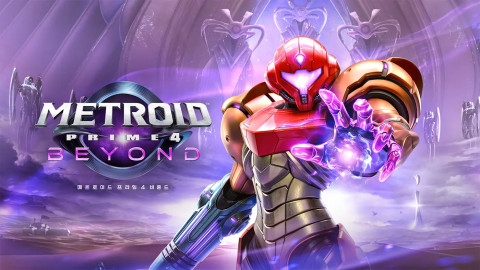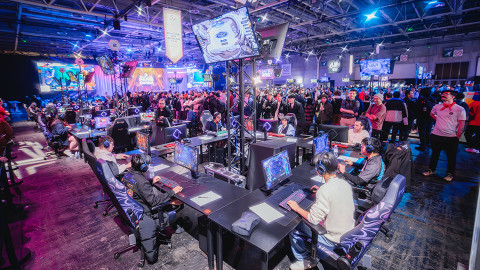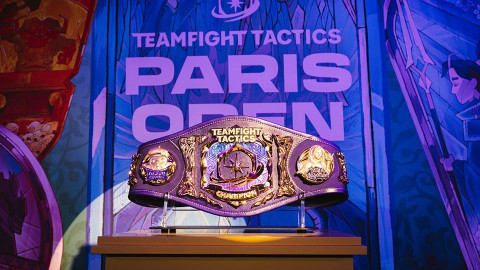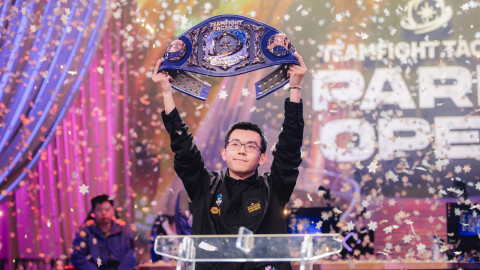
This article is part of The Makers of Faker. Click here to navigate and learn more about the series.
The Yongsan E-sports Stadium crowd cheered as Lee "Easyhoon" Ji-hoon walked to the mid lane. Standing across from his Karthus was a laughing LeBlanc — an unusual pick by rookie Lee "Faker" Sang-hyeok. It was only the second time fans saw the solo queue star competing in Korea’s premier competition — red headphones, a matching SK Telecom T1 sweater, and a black mop of hair almost covering the focused gaze on his face. At the time, the future legend was as mysterious as the lore described for his champion.
And like LeBlanc, he was about to perform some magic.
As the minion waves struck, Faker played a match that would cement him as one of the world’s most exciting players. It’s one of the closest examples of a perfect game of League of Legends: winning a lane matchup in which most would fail, securing kills most would be blind to, and doing so with a bravado and pace so demoralizing that the enemy soon surrendered.
It remains not only one of Faker’s most iconic performances but also one of the best League of Legends matches in history. He showed many attributes he’d become famous for: innovation, ingenious decision-making, and a control of the keyboard matching that of a concert pianist.
As his enemy self-destructed their Nexus, the OnGameNet camera cut to a shot of Faker. He was smirking, having earned an 11/0/2 scoreline. The broadcast then transitioned to Easyhoon frowning — no doubt disappointed in his team’s one-sided defeat and his 1/1/1 performance. Not the start you’d expect for one of the most interesting rivalries in esports history.

Easyhoon never had strong starts, though.
A Fateful Feud
Of the many duels Faker has had throughout his career, his battle with Easyhoon is the strangest. Facing him since the beginning of his career, the first two years against him are irrelevant. Besides the humiliation Faker put on Easyhoon’s team in that famous LeBlanc game, most of their encounters on the Rift were forgettable — mostly easy wins for Faker. The proper start of their competition against one another begins in 2015.

The year before then was rough for SK Telecom T1. Their teams (SK Telecom T1 S and SK Telecom T1 K) failed to qualify for Worlds, and several of their players no longer looked capable of playing at an elite level. Furthermore, it was announced that the Korean league would no longer allow esports organizations to have more than one roster — forcing KeSPA teams to merge their lineups.
It was a rebuilding year, and most of the choices looked simple. Many of T1’s players either retired or searched for opportunities in the West, with some promising building blocks remaining. They had talented young top and bottom lanes, as well as a veteran jungler. The only real decision was what to do for the mid lane.
There were two choices.
The first option was Faker — could there be a more reliable blue-chip? Most teams don’t have the privilege of possessing a World Champion still in top form. His performance throughout 2014 was disappointing, but only by his ridiculous standards. In spite of the decline of his teammates, all the qualities of the greatest player ever were still with him. He could roam the map and find plays few humans could see, turn surely-lost team fights on their heads, and display mechanical brilliance on a regular basis.
In 2014, it seemed every game had him dragging the former champions to a dirty victory. His performance in the NiceGameTV League of Legends Battle - Summer (NLB) is still one of the most impressive carry performances ever. Even with his team doing everything possible to drown him, Faker preserved its place as a top team in the region.

He was still a top player, with all the out-of-game strengths of a true champion. The mysterious prodigy was now a box-office draw — one of the most popular esports stars in the world. He was an ideal competitor: an insatiable genius with unending love for the game and ambition to win. His appetite to carry games in the most flashy way possible made him a spectacle few could match. And despite his high-profile runs for two years, he was still only a teenager. How could you go wrong, choosing him?
Then there was Easyhoon. Other than winning NLB with the amateur GSG, he had led a very underwhelming career up to that point. MVP Blue saw quick exits from both Champions and NLB, with similar results when he moved to SK Telecom T1 S. Even when his team made the semifinals of OGN Champions 2014 — better than SKT T1 K’s quarterfinal finish — more hype could be generated from Faker sneezing.

Easyhoon was misunderstood: much different from Faker, and most of the other top players in Korea. He had a genuine passion for esports and wanted to see it grow as an industry, but had a range of other interests. Known for his cerebral disposition, he had a unique taste for old foreign games and literature — some of his past solo queue IDs paying tribute to the North American game Baldur's Gate II: Shadows of Amn (Jon Irenicus) and the Chinese historical text, Records of the Grand Historian (日暮途远). One book Easyhoon was especially fond of was Justice by Michael Sandel. The book’s discussion of utilitarianism — sacrifice sometimes being required from a minority to create happiness for the majority — was something he applied a lot in his career.
Well...not for his gameplay. It says a lot about how he viewed himself that he dubbed himself Jon Irenicus, a calculating outcast villain. Another unique attribute of Easyhoon: his playstyle was mind-numbingly dull. It was all careful timing and positioning over technical flare. He won games on his terms, no matter how frustrating it was for enemy teams, commentators, and the rest of the world. He sacrificed their joy and entertainment for the success of him and his team — admirable, but frustrating to those that just wanted fun games of League of Legends.


An ideal Faker game saw him choose an unorthodox champion, scour the map for kills, and team fight his way to victory. An ideal Easyhoon game saw him select a basic control mage, farm like it was Stardew Valley through most of the game, and suffocate the enemy to a win. Many of his games went past sixty minutes — racking up 600+ CS in the ultra late-game. He was very dangerous to overseas viewers — capable of putting to sleep even the most caffeinated fans.
That’s not to suggest his style wasn’t effective. Faker himself stated he was one of the best mid laners he ever faced. On all his losing teams, Easyhoon was a shining outlier (1/1/1 in that LeBlanc game was great compared to the rest). He had great control of choke points, could farm in the hardest matchups, and was self-reliant enough to give his teammates opportunities to excel (something his bad teams rarely preyed on).
He was strong to those paying attention, and he was finally on a team that was succeeding — a roster that was the core of the new T1. Looking at everything, T1 had a tough choice. Should they go with their golden boy and trust he’d fit in well with a new lineup? Or should they go with the man most of the team had built a year of synergy with?

T1's answer? Both.
The Spring Swing
T1’s 2015 sixth man roster remains a very controversial coaching decision. At the time, though, it was heresy. Swinging games between the best player in the world to a low-profile snooze machine — fans and analysts scratched their heads.
While we may never receive the details explaining the decision, and can speculate thousands of reasons on why, Faker and Easyhoon have both stated the coaching staff’s thinking was that it would make for a more versatile team. SKT T1 coach Choi “cCarter” Byeong-hun’s comments on the decision and the general philosophy of the team are also telling:
“There are many cases where you have to deal with the team's problems in advance when you see cases where you are not satisfied with the content regardless of the result of the match,” cCarter stated. “One of those preparations was the appointment of the sixth man, and I think that it produced good results according to the situation. And the sixth man system motivates the players.”
That’s the other point: motivation. Faker had the might of Achilles, but T1 wanted to make sure the heel was covered. They'd compete for the starting position — selected for the best fit for specific games. And at the beginning of 2015, that varied wildly.
As Spring began, the contrast between the two was yin and yang. Faker did everything he was famous for. Lots of dangerous champions, consistent ban draws, and an incredible scope for plays (especially in the early game). His mechanical prowess on top of that was as sharp as ever — slicing through enemy lineups in brilliant fashion.


Easyhoon was less skilled, but in certain situations more effective — something that often occurred in the spring meta. Throw him a Xerath or a Cassiopeia, and he could do things even Faker couldn’t — in fact, changing T1's dynamic.
Because of his turtle shell playstyle, Bengi didn’t have to provide vision for the mid lane (both T1 junglers acknowledge Easyhoon's generosity), and could help other lanes shine instead. He wasn’t as impactful in the early game, but prevented the opposing mid laner from freely CSing or appearing in dragon fights. Maurice "Amazing" Stückenschneider’s experience with both players summarize it well: "At the very playstyle that they played with Easyhoon, I think they probably were better than with Faker. But in every other playstyle, and in every other scenario, Faker was a better player than Easyhoon.”

Judging their regular season stats, it was clear the sixth man experiment worked. Faker had a 4.4 KDA to his adversary's league-leading 9.2. Amazing’s comments prove true for Spring — Easyhoon having a 75% win rate compared to Faker’s 70%. The coaching staff went with the more winning combination for the Spring Finals. T1 swept, with the greatest player of all time sitting on the bench.
“There was a lot of noise about the competition for starting in our team”, Easyhoon said of the time. “A lot of noise” is putting it mildly. The noise of complaints was like a metal concert cross firework show filled with newborn infants, struck by the Tunguska Meteor. Despite how successful the strategy was, most of the League community did not come around.
Fans far and wide wanted Faker alone. Even influential community figures then-and-now displayed frustration for the roster strategy. "It does diminish some of Faker's legacy, because he was not used in significant moments" Christopher "MonteCristo" Mykles told Inven Global. "It did rob us of a lot of potential games that Faker could have played in."

Easyhoon understood the frustration and played every game with enormous pressure. But even with top statistics and a Playoffs MVP, the enthusiasm for him was still nill. No matter what, it was like swapping Michael Jordan with James Harden. He was still an elite player, but was standing in the way of the chosen one. He was replacing fire and explosions with drying paint. Easyhoon was preventing destiny.

The sixth man kept on, because he loved the game and his team and wanted them to succeed. The noise would go from ten to eleven, though, at the infamous 2015 Mid Season Invitational. Though T1 plowed through to the finals, a supercharged EDward Gaming stood between them and the trophy. Famously, EDG’s genius Morgana countered Faker’s undefeated LeBlanc in Game 5 — leading to T1’s first international loss and Faker’s first time losing on his famed pick.
EDG's strategy received praise, but much of the community insisted they shouldn’t even have been able to use it. They felt the reason T1 were in a deciding game was their use of Easyhoon dragging them to 1-2. Faker subbed in for Game 4, and immediately dominated. The fact that the lost Easyhoon games allowed EDG to play their trump card left a lot of people bitter. If only Faker had played from the start.
The results could’ve been demoralizing for any player in Faker’s position. Losing in one of the biggest tournaments, the tensest moment, all while duped on one of your signature champions: it had to sting. Especially when he wasn't allowed to play from the beginning.

With such a big juncture, it seemed like a crossroads. Many legendary champions before him had fizzled out after a year or two. He was playing in his weakest meta ever. He could've fallen into a slump, requested to join another team, or even quit — players have done all three for less. But then again, it was Faker. He’d grind even harder than before to make sure the result didn't happen again.
Easyhoon would also have challenges ahead of him: the ire of fans amplified double. “Winning cures everything” didn’t prove true for him — now it'd be even worse. And he’d have Faker breathing down his neck even harder.
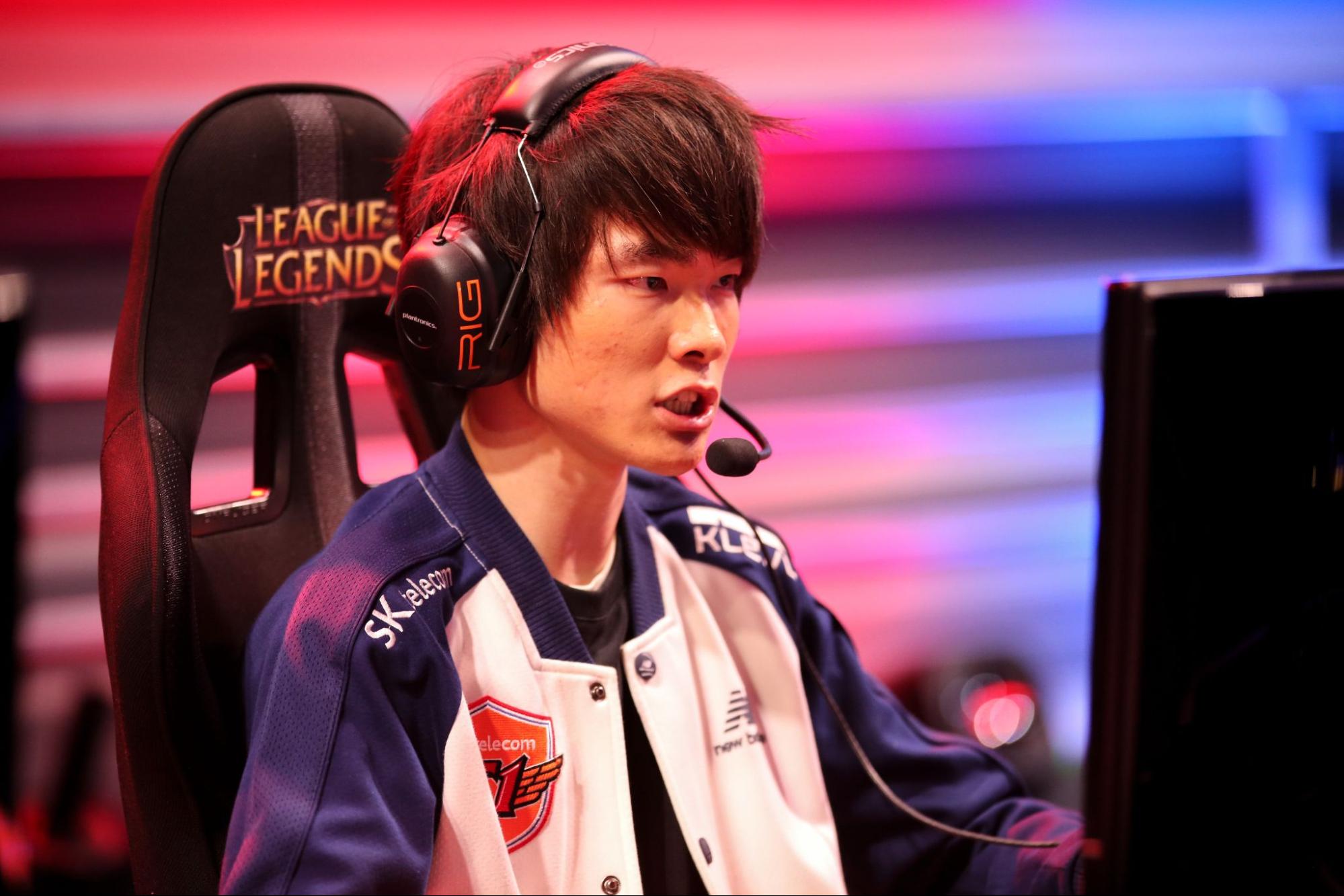
The two runner-ups returned to Korea, both with a lot on their plates.
Making A Martyr
As summer came to season, the grind Faker put in was as clear as day — it’s one of the most spectacular forms we’ve seen him in. His early game playmaking was more frequent, his calculations finer, and he had irrigated his champion pool to include several high-importance picks. The team was more successful with him — their win rate going from 70% to 83%.
“I also didn't have many complaints even when I didn't get enough starting positions during the summer split,” Easyhoon reflected. “Faker was relatively better than me and thus started more often, and I understood because the judgment was up to the coaching staff and their decisions were reasonable.”

Easyhoon wasn't playing poorly. He expanded his champion pool, had some of the best stats in the league, and still had a higher win rate than Faker (not accounting for the strength of teams played). He took every opportunity and ran with it — the team lost only one game with him in Summer.
It didn’t matter. It was a shoving match between the two during spring, but Faker’s push in summer form was like one from One-Punch Man. He played almost three times as often during the regular season, and took sole responsibility of sweeping the finals of that tournament. In the meager games Easyhoon won, fans continued complaining.

It’s wild to think there could be any dejection for anyone on T1 during the 2015 World Championship. With a 94% win rate, they're often argued as the greatest team in the history of the competition. The way Faker takes back the crown in this tournament is all-time classic footage. The number of iconic plays he made here exceed most players' entire careers.
Easyhoon also had a fantastic showing. He won all four of the games he played, and had an 11.3 KDA. An undefeated streak and the Summoners Cup in hand — how could one experience anything but pure elation?

Easyhoon’s life changed during the semifinals against Origen. Though he had only played two games at that point, the coaching staff thought Easyhoon was a better fit against the European squad. Judging by how he performed, it was a good call. He was the best performer in the first game, and had an undefeated match on Orianna in the second. Going 8/1/11 in two wins during the biggest competition in the world, it was an absolute dream.
However, reality slapped him in the face.
Don’t misunderstand: his performances were real, but his perception of himself and his role on T1 changed. He was slapped awake to enthusiastic audience shouts of “Faker!” Even after fighting his best, songs of his rival continued to fill the air. And in spite of his showings, T1 decided to let Faker finish the series.
He took it like a professional: trusting the coaching staff's judgment, playing solo queue during the third game to stay sharp, and delivering a great interview. However, he admits that it hurt. Upon leaving the stage, questions began to swarm into his head. What was his role on the team? What was his role in esports? Didn’t people ultimately want Faker?

As mentioned before, Easyhoon believed in the ideal of a minority sacrificing, so the rest of society could be happy. That wasn't reflected in his dull gameplay — the only people that ever benefited were him, his team, and the weirdos that actually enjoy farm-heavy gameplay (seriously, what is wrong with you people?). It was a sacrifice in a way: he set aside personal adulation for the good of his team. Yet, he realized there was another team he was playing for: those that love esports.
Through 2015, Easyhoon accomplished feats that were extraordinary: keeping pace with the greatest player of all time, often edging ahead. But now, he would do something arguably greater: he’d step aside.
Shortly after lifting the Summoners Cup with the most prestigious team in esports, Easyhoon left the organization to clear the way for Faker — competing for the rest of his playing career in China with Vici Gaming. “In living closely with Faker, I have observed what an amazing player he is, and I sincerely hope he can keep performing well and continue filling his role. For progress of esports and League of Legends”, Easyhoon stated in an interview. He wouldn't spit on the ground and fight the public's love of Faker — he recognized his value to the game and scene he loved. He'd embrace, and play a role of his own.
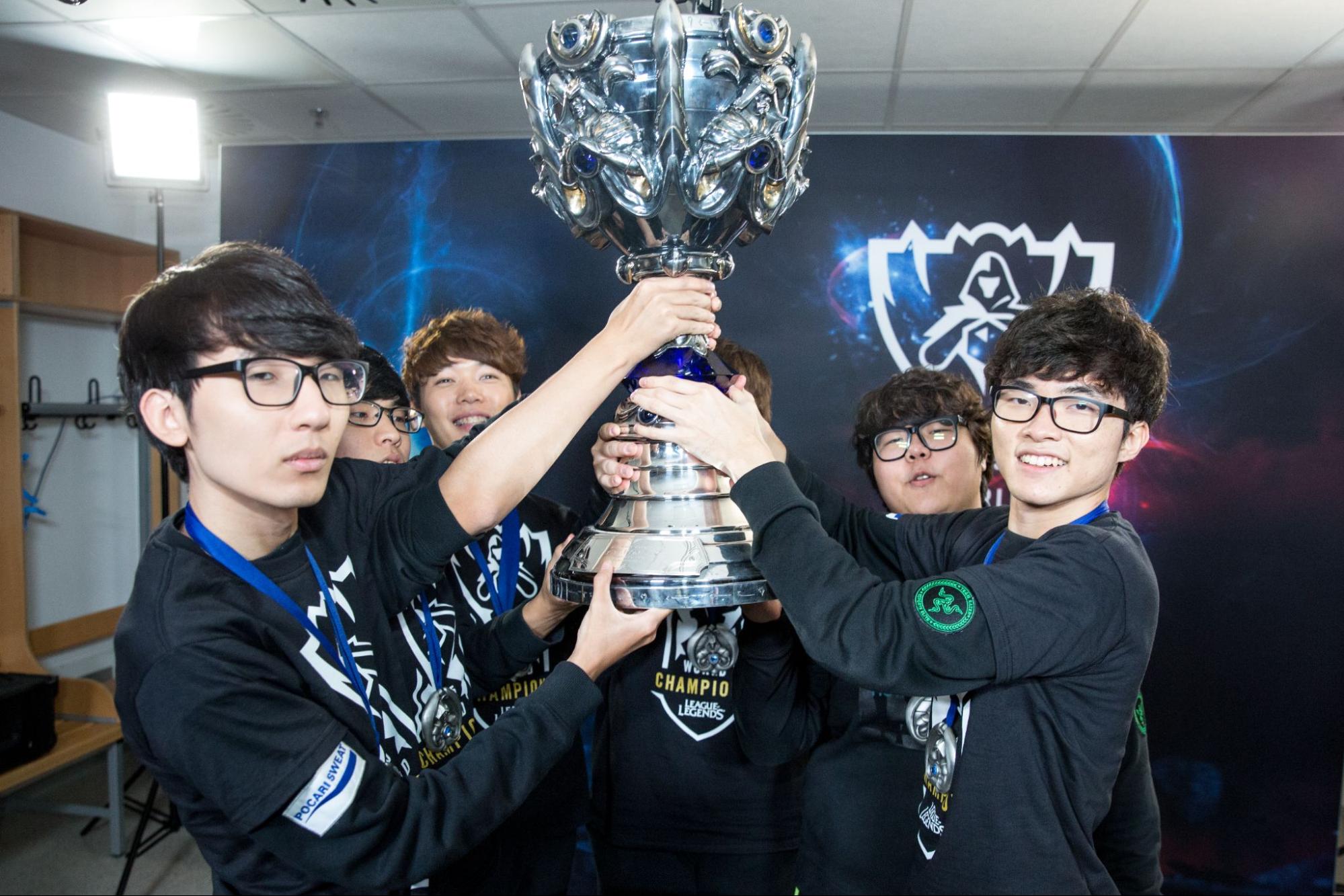
Easyhoon is one of the most significant players in Faker’s career, and not only by helping him win championships. By pushing him to be better — the sixth man experiment helped Faker reach new heights. Even more important, he sacrificed his glory on T1 so Faker could fully shine for esports. He was letting destiny fulfill itself.
"Let's say there's a time where I'm sitting in 20 years watching Faker games, knowing that maybe there could have been more games,” Jakob "YamatoCannon" Mebdi told Inven Global. “Maybe there was some more form of beauty that could have been shaped when Faker was in his absolute prime back in 2013 and 2015 — if we missed out on games when he was in that form, that idea is just sad. So it's nothing against Easyhoon, it could be any other mid laner next to him." Imagine how many games Easyhoon gave us back by stepping down.
You could argue that his reasoning for quitting wasn't as romantic as he said. Perhaps he saw the writing on the wall for his T1 career, and was trying to save face. That could be true. But there's no reason for us not to believe him, and the lesson he's given with his purported choice is invaluable.

Both for esports and all of life, everyone has a role to play. Not everyone has to be the ultimate hero. Sometimes, instead of fighting for the spot that gives the most glory and awe, it's better to recognize our position and do it to the best of our abilities.
Easyhoon saw his role, and he saw Faker's. He stepped aside for the good of all in our weird little corner of the world. It couldn't have been an easy choice, but given how much the game and the space has grown in the past decade — in no small part to the icon Faker continues to be — it's worked out. Easyhoon plays the long-game, and it looks like he's won again.
-

I write. I rap. I run. That’s pretty much it.
Sort by:
Comments :0


